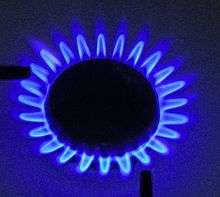Water gas
Water gas is a mixture of carbon monoxide and hydrogen produced from synthesis gas. Synthesis gas is a useful product, but requires careful handling due to its flammability and the risk of carbon monoxide poisoning. The water-gas shift reaction can be used to reduce the carbon monoxide while producing additional hydrogen, resulting in water gas. Fuel gas consisting mainly of carbon monoxide and hydrogen, made by passing steam over incandescent coal
Production
Synthesis gas is made by passing steam over a red-hot carbon fuel such as coke:
The reaction is endothermic, so the fuel must be continually re-heated to keep the reaction going. In order to do this, an air stream, which alternates with the vapor stream, is introduced for the combustion of carbon to take place.
Theoretically, to make 6 L of water gas, 5 L of air is required.
Or, alternatively, to prevent contamination with nitrogen, energy can be provided by using pure oxygen to burn carbon into carbon monoxide.
In this case 1 L of oxygen will create 5.3 L of pure water gas.
History
The water-gas shift reaction was discovered by Italian physicist Felice Fontana in 1780.
Water gas was made in England from 1828 by blowing steam through white-hot coke.[1]
Lowe's gas process
In 1873, Thaddeus S. C. Lowe developed and patented the water gas process by which large amounts of hydrogen gas could be generated for residential and commercial use in heating and lighting. This gas provided a more efficient heating fuel than the common coal gas, or coke gas, which was used in municipal service. The process used the water-gas shift reaction:
The process was discovered by passing high-pressure steam over hot coal, the major source of coke gas. Lowe's process improved upon the chimney systems by which the coal could remain superheated, thereby maintaining a consistently high supply of the gas. The reaction produced carbon dioxide and hydrogen, which, after a process of cooling and "scrubbing", produced hydrogen gas.
The process spurred on the industry of gas manufacturing, and gasification plants were established quickly along the Eastern seaboard of the United States. Similar processes, like the Haber–Bosch process, led to the manufacture of ammonia (NH3) by the combining of nitrogen, found in air, with hydrogen. This spurred on the refrigeration industry, which long used ammonia as its refrigerant. Prof. Lowe also held several patents on artificial ice making machines and was able to run successful businesses in cold storage, as well as products which operated on hydrogen gas.
Variations
Carburetted water gas
Water gas has a lower heat of combustion than coal gas, so the calorific value was often boosted by passing the gas through a heated retort, into which oil was sprayed. The resulting mixed gas was called carburetted water gas. The average composition of carburated water gas is as follows: H2=34-38%; CO=23-28%; saturated hydrocarbon=17-21%; unsaturated hydrocarbon=13-16%; CO2=0•2-2•2%; N2=2•5-5•0%. It is used as a source of heat since it has a high calorific value
Semi-water gas
Semi-water gas is a mixture of water gas and producer gas made by passing a mixture of air and steam through heated coke. The heat generated when producer gas is formed keeps the temperature of the coke high enough to allow water gas to be formed.
Water gas shift reaction
Pure hydrogen can be obtained from water gas by using the water-gas shift reaction, after subsequent removal of the carbon dioxide formed when carbon monoxide reacts with water.
Uses
- Used to remove carbon monoxide from fuel cell applications.
- Used in Fischer–Tropsch process.
- Reaction with producer gas to produce fuel gas.
- Used to gain pure hydrogen for synthesis of ammonia.
See also
References
- Singer, Charles; et al., eds. (1954–1978). A History of Technology. Clarendon Press.
- Mellor, J.W., Intermediate Inorganic Chemistry, Longmans, Green and Co., 1941, pp. 210–211
- Adlam, G.H.J. and Price, L.S., A Higher School Certificate Inorganic Chemistry, John Murray, 1944, page 309
- History e-book project. ACLS Humanities E-book. Vol 5. "The use of mineral oil" p. 119
- The chemistry of gas lighting, 1850.
